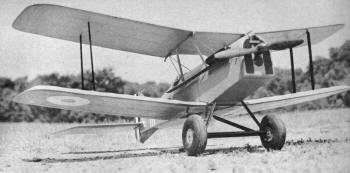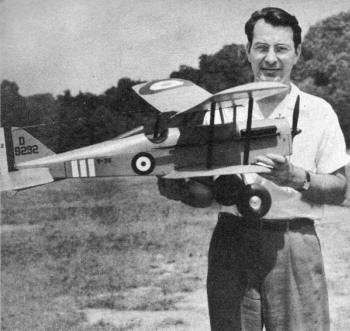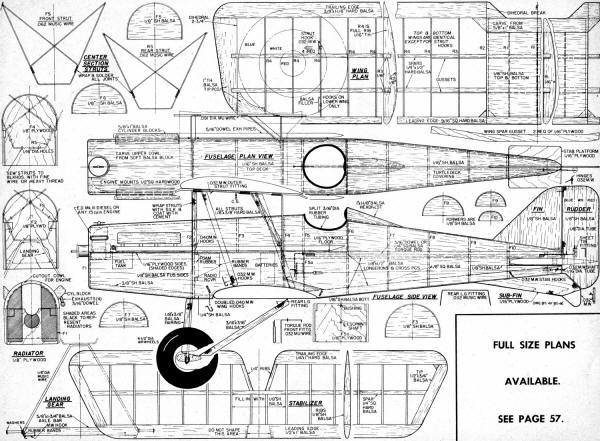|
Here
is a nice, lightweight WW I British SE-5 biplane for radio control.
The original was rudder-only (RO) with a .15 size diesel engine for power. Designed
by well-known (at the time) scale modeler Chet Lanzo, this model features
break-away top and bottom wings and oversize air-filled wheels to help make
hard than normal landings more survivable. A modern 3-channel setup with
an electric motor should serve the SE-5 well, and would most likely yield
an even lighter ready to fly weight than the original configuration. All
copyrights (if any) are hereby acknowledged. You might be able to buy full-size
plans from the
MAN plans
service. See all
Model Airplanes
News items. The SE-5
By Chet Lanzo

Both top and bottom wings knock off in event of a crash or, shall
we say, hard landing? Excepting airwheels and stabilizer area, everything
is to scale.

Chet Lanzo, who designed the SE-5, is one of the greatest competition
fliers of modeling history and specializes in rubber and scale aircraft.
|
Flown with notable success both as a free flight and radio controlled job,
this man-sized scale model of famous SE-5 fighter is unforgettable.
Flying scale models of the familiar SE-5A pursuit airplane of World
War I have always shown excellent flight characteristics. Having built quite
a few free flight models of this ship in the past, I felt that it would
make a good radio control scale model. Subsequent radio control and free
flight trials have proved it a sweet flying job. This model is true
scale with but two deviations from the full size plane: larger than scale
wheels are used and stab area has been increased. The air wheels have proved
to be well worth the slight loss in scale appearance because of the amount
of shock and beating the landing gear takes. The elevator area has been
increased slightly to 20 per cent of the wing area to improve flight stability.
The British SE-5 of World War I fame is one of the very few full
size machines that incorporate adequate dihedral for model flying purposes.
Rugged construction is very important in a radio control job and
the general beefing up of this model with plywood and wire has paid off
after a number of hot landings. The SE-5 has flown into trees of the thorn
apple variety without any apparent damage. Adding to the crash resisting
ability of the plane are the knock-off upper and lower wing panels, stab
and wing struts. On a few occasions previous to the installation of the
radio control gear, the model was flown free flight with very satisfactory
results. The biplane configuration with the upper wing set at plus 2 to
3° and the lower wing at zero° incidence makes a very stable arrangement.
The upper wing goes into a stall sooner than the lower wing at high
angles of attack, and with the coupling about the CG produces a restoring
moment without the usual loss in altitude accompanying a normal stall.
Experience with the ED 2.46 cc Diesel shows it makes a reliable,
easy-starting power plant which I recommend highly, although almost any
.15 glow plug engine will produce more than adequate power for this ship.
Some difficulty was experienced with the single hard tube receiver
installations because of the large amount of wire used in the bird cage
type of wing mount. Upon grounding of the wire to the B Minus side of the
receiver, this difficulty disappeared. Warping up the trailing edges (washout)
of all four of the wing tips to about 1/2 in. produces a model with improved
stability in turns under power and in glide. Top and bottom wing
panels are built flat over plans, dihedral being added later. Upper and
lower wings are identical except the lower wing has the interplane strut
hooks on the upper surface. Pin down pre-shaped leading and trailing edges,
then add ribs. Next, wing tips and center section blocks. Put in 2-3/4 in.
dihedral angle and spars and 1/16 dihedral braces of plywood. Sheet the
center section and cover the completed panels with silk .. Stab is constructed
in a manner similar to that of the wings. To construct fuselage,
cut from 1/16 in. plywood the two side pieces that extend from the nose
to former No.3. Place in position on plan. Pin down 1/8 x 1/2 in. longerons
and cement in 1/8 in. sq. vertical pieces. Remove from plan and cement on
1/8 sheet curer covering. Cement body sides to former No. 1. Add nose former
and fill in remaining crosspieces and formers. After assembling
wire wing mount and bending landing gear to shape, secure in place with
copper wire and plenty of cement. Rudder and fin are of solid 1/8 sheet.
Cover formers with 1/16 sheet balsa and, upon completion, the body is covered
with silk. Installation of receiver is conventional: any commercial
set may be used. I built a one-tube receiver and used a standard two-position
escapement. A convenient location for the switches and meter jack is the
easily accessible open cockpit. Radio tuning and adjusting are done
with the lower wing removed.

SE-5 Plans
Notice:
The AMA Plans Service offers a
full-size version of many of the plans show here at a very reasonable cost. They
will scale the plans any size for you. It is always best to buy printed plans because
my scanner versions often have distortions that can cause parts to fit poorly. Purchasing
plans also help to support the operation of the
Academy of Model Aeronautics - the #1
advocate for model aviation throughout the world. If the AMA no longer has this
plan on file, I will be glad to send you my higher resolution version.
Try my Scale Calculator for
Model Airplane Plans.
Posted January 19, 2014
|



